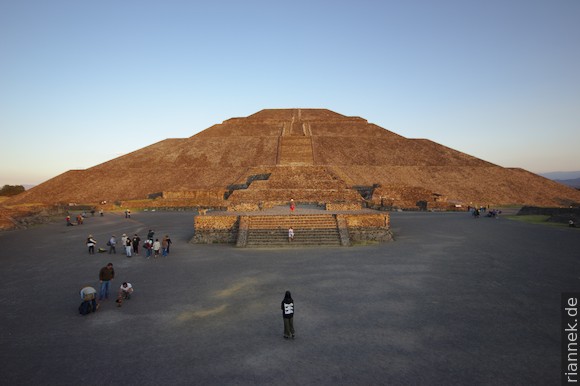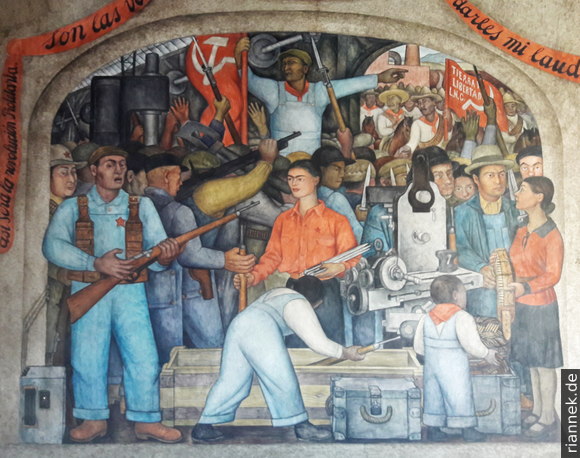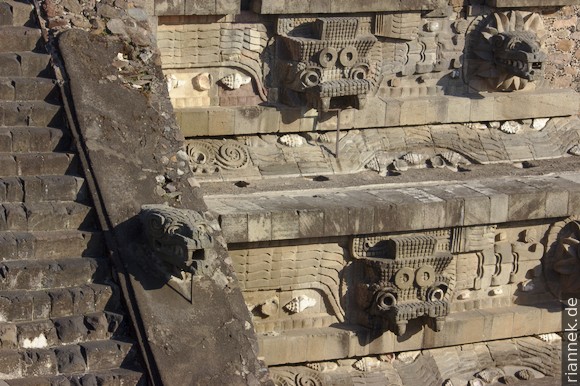
In the megacity of Ciudad de Mexico, besides the historic centre and lively markets, I am particularly interested in the numerous first-class museums. In the National Museum of Anthropology alone, I spend an entire day admiring works of art from the Aztecs, Toltecs, Zapotecs, Mixtecs, Olmecs, Mayas, Teotihuacán, etc. I was not aware of how many advanced civilisations there were in Central America before this trip. Their sculptures, ceramics, frescoes and jewellery are impressively beautiful and varied, some of them quite creepy.
I see even more of the Aztecs in the museum at the Templo Mayor. The remains of the most important temple of their capital Tenochtitlán were excavated at the Zócalo right next to the cathedral. The Aztecs repeatedly built over the pyramid with a larger one; accordingly, the foundation walls of 7 pyramids can be seen like onion skins.

The cathedral next door (Renaissance, Baroque) is also impressive, although its bloody history is not visible. In the surrounding area, there are always buildings with crooked walls; the former lake landscape is clearly not a good building site.

A day in southern districts revolves around Frida Kahlo and Diego Rivera. I start with the Casa Azul, where Frida Kahlo lived for a large part of her life, at times also Diego Rivera (and briefly also Leon Trotsky). A spacious old building with a large green courtyard, with some paintings, photos, the wheelchair in front of the easel…
A few streets away is the much more spartan house of Leon Trotsky. It was surrounded by a high wall with a watchtower and had armoured doors, which as we know didn’t help. Trotsky had what was certainly a state-of-the-art dictaphone at the time, a large box that recorded dictation on wax drums, a similar box in the secretary’s office played it back. Otherwise, the furnishings are very simple, also in terms of the museum’s equipment.
In the neighbouring district is the Museo Casa Estudio Diego Rivera y Frida Kahlo, where he lived for a long time and she for a short time. I was only able to visit his studio. It is three interesting early modern houses — lots of glass, spiral concrete staircases outside, a bridge between his house and hers — built by an architect friend who lived in the third house.
Further south, I walk across the campus of the university (UNAM), which has almost 10 times more students than so-called mass universities in our country. The modern architecture of the 1950s was considered groundbreaking; the mosaic-clad library is particularly interesting.
I take a suburban train further south to the Museo Dolores Olmedo. In a former hacienda, there is a very good collection of paintings by Diego Rivera and Frida Kahlo.

Diego Rivera’s murals in representative buildings in the centre, for example the National Palace or the Ministry of Education, are also impressive. In the latter, an entire cycle revolves around class struggle: armed workers taking their fate into their own hands under red flags. It is astonishing that he could paint such propaganda images full of red stars in a government building: A few years after the Mexican Revolution, in which Pancho Villa and Emiliano Zapata fought for “land and freedom”, but in the end only a bourgeois-liberal republic emerged.
The Museo Soumaya shows what comes out when a super-rich man wants to show off his private collection. The architecture is deliberately spectacular (too deliberately) and the contents look expensive but thrown together. There is great art (e.g. El Greco, Filippo Lippi, Rufino Tamayo, Rodin) between a lot of mediocre paintings (even if there is a name like Degas underneath). Does there really have to be a whole floor full of Venice paintings? Another one full of Chinese ivory carvings, another one full of silver spoons and coins?
I prefer: Museo Jumex, Museo Rufino Tamayo, Museo del Arte Moderno, Museo Mural Diego Rivera, Palacio de Bellas Artes.

I also find the four huge meteorites at the entrance to the Palacio de Minería very impressive, the largest weighing more than 14 tonnes.

The surroundings of Mexico City also have a lot to offer. A real highlight is a day trip “to the pyramids”, to Teotihuacán. This was the first really large city in the Americas, from the 1st to the 8th century. The Pyramid of the Sun, built around 150, is the third largest in the world (after Cholula and the Cheops pyramid.

Somewhat smaller and almost more beautiful is the Pyramid of the Moon. There is, of course, much more to see, the plazas surrounded by platforms, reliefs on columns and walls, very interesting frescoes and a small stepped pyramid from whose walls the head of the feathered serpent keeps protruding.

I wasn’t exactly alone here: I happened to have caught a holiday and the old main street was packed like a marketplace. In the afternoon, a queue pushed its way up to the top of the great pyramid and down again, without pause and using the entire width of the stairs. The tail of the human serpent reached along the base a quarter of the way around the pyramid. Or was it Quetzalcóatl, the feathered serpent?

Tula was the metropolis of the Toltecs, chronologically between Teotihuacán and the Aztecs. The main thing to see are the four giant atlases standing on the small pyramid, so called because they once supported the roof of the temple (only the middle ones are original, the one on the left is actually in the National Museum in Mexico City).

They are dressed very strangely for warriors: With a very short apron and bare bottom. In addition, a shield in the shape of a butterfly in front of the chest and a high feather ornament on the head.

On the way to Tula, it is worth stopping in Tepotzotlán, where there is once again a magnificent baroque church and next to it a monastery (museum).
Schließlich mache ich noch einen Tagesausflug nach Taxco (mehr als 3 h entfernt). Und als letzte Höhepunkte besteige ich die Berge Nevado de Toluca und Iztaccíhuatl.
Finally, I make a day trip to Taxco (more than 3 h away). And as last highlights, I climb the mountains Nevado de Toluca and Iztaccíhuatl.
Read on
From Cancun to Mexico City
Nevado de Toluca
Iztaccíhuatl
Puebla and Cholula
El Chichón